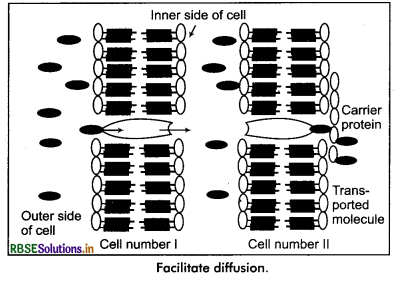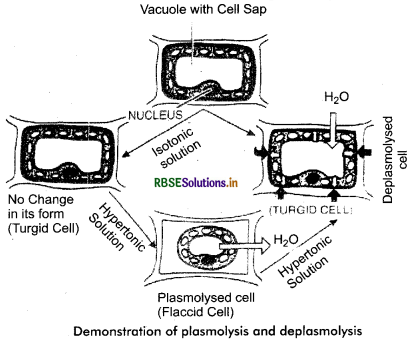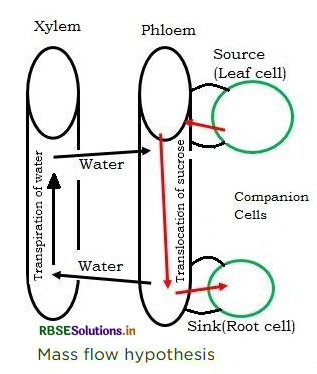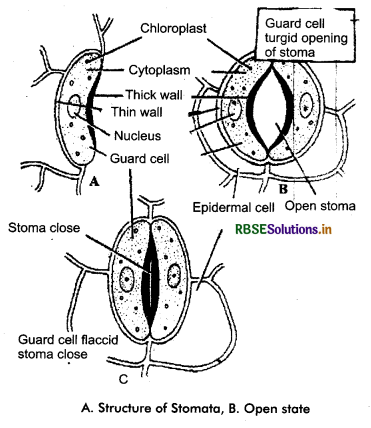RBSE Solutions for Class 11 Biology Chapter 11 Transport in Plants
Rajasthan Board RBSE Solutions for Class 11 Biology Chapter 11 Transport in Plants Textbook Exercise Questions and Answers.
Rajasthan Board RBSE Solutions for Class 11 Biology in Hindi Medium & English Medium are part of RBSE Solutions for Class 11. Students can also read RBSE Class 11 Biology Important Questions for exam preparation. Students can also go through RBSE Class 11 Biology Notes to understand and remember the concepts easily.
RBSE Class 11 Biology Solutions Chapter 11 Transport in Plants
RBSE Class 11 Biology Transport in Plants Textbook Questions and Answers
Question 1.
What are the factors affecting the rate of diffusion?
Answer:
Factors affecting Rate of Diffusion: There are mainly four factors which affect the rate of diffusion:
- Temperature: The rate of diffusion increases with an increasing in temperature because kinetic energy of diffusing molecules increases.
- Density of diffusing substance: The rate of diffusion of a substance is inversely proportional to the square root of its density.
\(D \propto \frac{1}{\sqrt{d}}\)
where, D = Rate of diffusion,
d = Density of substances - Medium in which diffusion Occurs: On increasing the concentration of the medium, the rate of diffusion decreases and on decreasing the concentration, it increases.
- Diffusion Pressure Gradient: The greater the difference in the diffusion pressure the faster is the rate of diffusion.

Question 2.
What are porins? What role do they play in diffusion?
Answer:
Porins: Porins are protein molecules present in external membrane of bacterial cells, mitochondria, plastids etc. They form big pores in external membrane which provide passage of large molecules to cross the membrane. These paths may be open always or closed. Some paths are so big, through which small protein molecules can pass.
The given figure shows an extracellular molecule bound to the transporter protein; the transporter protein then rotates and releases the molecules inside the cell. In nerve cell, the transportation of sodium-potassium from nerve membrane is controlled by electric - potential change, Na+ and K+ gate open and close due to electric change.

Question 3.
Describe the role played by protein pumps during active transport in plants.
Answer:
In active transport, the transport of molecule takes place against the concentration gradient. For this purpose the energy is needed. Active transport is done by membrane protein. Hence, different proteins of membrane play role in both active and passive transport. The pump is a special protein which uses energy for passing molecules or particles through membrane. These pumps, can pump protein substances from lower concentration to higher concentration. The speed of transport is maximum when all transporter proteins are used. Like enzymes carrier proteins are also highly specific to passing substances. These proteins are also sensitive against inhibitors which react with side chains.
Question 4.
Explain why pure water has the maximum water potential?
Answer:
The water molecules have their own energy therefore, they keeping motion continuously. The kinetic energy of water molecules in pure water is maximum. On dissolving solute in pure water, the kinetic energy of water molecules reduces and generally free energy of water molecules decrease. Hence, the water potential of water molecules in pure water is maximum than solution.
Question 5.
Differentiate between the following:
(a) Diffusion and osmosis.
(b) Transpiration and evaporation.
(c) Osmotic pressure and osmotic potential.
(d) Imbibition and diffusion.
(e) Apoplast and symplast pathways of movement of water in plants.
(f) Guttation and transpiration.
Answer:
(a) Difference between Diffusion and Osmosis
|
Diffusion |
Osmosis |
|
1. It is the movement of small particles in which molecules of different substances move according to their concentration coefficient. |
1. It is the movement of only solvent molecules or water in which they move according to their chemical potential coefficient. |
|
2. Each substance shows free diffusion. |
2. Solvent molecule do not diffuse. |
|
3. Takes place in each type of medium. |
3. Takes place only in liquid medium. |
|
4. No requirement of semipermCable membrane. |
4. It requires semipermeable membrane. |
|
5. Does not affect by the presence of other substances. |
5. It is affected by other substances specially of solute molecules. |
|
6. No specific pressure created. |
6. Osmotic pressure creates which depends on concentration of solution. |
(b) Difference between Transpiration and Evaporation
|
Transpiration |
Evaporation |
|
1. Transpiration is a vital process. |
1. Evaporation is a physical process. |
|
2. This process mainly occurs by stomata. |
2. This can takes place through any surface. |
|
3. Water evaporates in the form of vapour from aerial parts of plants. |
3. Water evaporates in the form of vapour from any open surface of water. |
|
4. It is regulated process. |
4. It is non - regulated process. |
|
5. The loss of water per unit area is more. |
5. The loss of water per unit area is less. |
|
6. Various pressures such as suction pressure, osmotic pressure etc., takes part in transpiration. |
6. It is not controlled by any pressure. |
(c) Difference between Osmotic Pressure and Osmotic Potential
|
Osmotic Pressure |
Osmotic Potential |
|
1. It shows the pressure created by osmotic energy of water in an osmotic system. |
1. It is a decrease in free energy of water due to presence of solute particles. |
|
2. It is denoted by OP. |
2. It is denoted by ψs. |
|
3. It can be measured, it measured in bars (one megapascal = 10 bars). |
3. It cannot be measured. |
|
4. It is positive (+ve). |
4. It is negative (—ve). |
|
5. It is equals and is opposite to osmotic potential. |
5. Numerically it is equal to osmotic pressure but with negative sign. |
(d) Difference between Diffusion and Imbibition
|
Diffusion |
Imbibition |
|
1. In this, movement of small particles according to concentration |
1. In this absorption of water takes place by solid surface. |
|
2. All substances show free diffusion. |
2. The molecules of solid do not show diffusion. |
|
3. No any pressure is created. |
3. It creates high imbibition pressure. |
|
4. No attraction require between molecules or ions. |
4. It needs attraction between absorbant and molecules of medium. |
(e) Difference between Apoplast and Symplast Pathways of Water Absorption
|
Apoplast Pathway |
Symplast Pathway |
|
1. It is the system of immediate cell walls. It is found in all the plants except casparian strips of endodermis. |
1. It is the system of relative protoplasms. Immediate cells joined with cytoplasmic strands. |
|
2. It is present only in intercellular space and cell walls. |
2. It takes place through protoplasm of cells and cytoplasmic strands. |
|
3. The speed of transportation depends on gradient. It is basically takes place due to diffusion and cell activity. |
3. It takes place through protoplasm of cells and cytoplasmic |
(f) Difference between Guttation and Transportation
|
Guttation |
Transportation |
|
1. It occurs during night or in the morning. |
1. It occurs during day. |
|
2. Water comes out in the form of liquid. |
2. Water comes out in the form of vapour. |
|
3. It occurs by hydathodes. |
3. It occurs by stomata, cuticle or lenticels. |
|
4. Various types of substances are dissolved in guttation water. |
4. Water vapour is pure. |
|
5. It is a non regulated process. |
5. It is a regulated process. |
Question 6.
Briefly describe water potential. What are the factors affecting it?
Answer:
Water Potential: The difference between the free energy of water molecules in pure water and that of water in any other system (e.g., water in a plant cell or in a solution) is termed as water potential. It is represented by a greek letter psi (Ψ). It is also represented as ys and measured by pressure unit pascal (Pa).
1 bar = 145 lb/n2 = 750 mm Hg = 0.987 atm
The water potential of a system is equal to diffusion pressure deficit but negative (-ve) in value because its maximum value for pure water is zero. The free energy of water molecules is reduced in the presence of solute particle due to which the water potential becomes negative. The concentration gradient and pressure are the factors which affect water potential.

Question 7.
What happens when a pressure greater than the atmospheric pressure is applied to pure water or a solution?
Answer:
If more pressure than atmospheric pressure exerted on pure water or solution, then its water potential increases, it is equals to pump water from one place to other. When water enters into cell due to diffusion, it increases the turgidity of cell and pressure potential. Pressure potential is usually positive. Though in plants negative potential or tension in water column of xylem play as important role in water conduction in stem.
Question 8.
(a) With the help of well - labelled diagrams, describe the process of plasmolysis in plants, giving appropriate examples.
(b) Explain what will happen to a plant cell if it is kept in a solution having higher water potential.
Answer:
(a) Plasmolysis: When a plant cell is placed in a hypertonic solution, the process of exosmosis occurs in it and water from cell sap begins to diffuse into outer solution resulting into the shrinkage of protoplasm. This phenomenon is called plasmolysis and the cell is called plasmolysed cell.
The cellwall of a plant cell is fully permeable, in plasmolysed cell the space between shrunken protoplasm and cellwall gets filled up with outer solution. The initial stage of plasmolysis is called incipient plasmolysis. As long as exosmosis goes on, the shrinkage of protoplasm continues and ultimately this shrunken protoplasm is seen surrounded by plasma membrane either in the middle or at the corner of the cell. When a plasmolysed cell is placed in hypotonic solution, the protoplasm regains its original position due to the process of endosmosis. It is called deplasmolysis.

(b) If a plant cell is placed in a solution having high water potential, the water molecules enter into cell and the cell becomes turgid.
Question 9.
How is the mycorrhizal association helpful in absorption of water and minerals in plants?
Answer:
The roots of many higher plants such as Pinus, Cidrus, oak etc., are infected by fungi. Fungal mycelia forms ectomycorrhiza and endomycorrhiza on surface or in cortex respectively in roots of these plants. In this type of symbiosis the fungus provide water and mineral salts absorbing from soil and gets their food from root of plant.
Some angiosperms e.g., Neottia, Monotropa etc. also show mycorrhizal symbiosis. If fungal association is not available to these plants they died. If fungal symbiosis is not found to seedling of Pinus, they cannot survive.
Question 10.
What role does root pressure play in water movement in plants?
Answer:
Root Pressure: Due to high concentration of root hair cells, the water enter into these cells from soil, as a result these cells get turgid. To region normal position these cells transfer water to cortical cells, thereby cortical cells get turgid. Due to this turgidity the pressure created in roots, is called root pressure.
Root pressure is generally +1 to +2 bars, due to this water ascents at some height. There is no root pressure in dry soil. By root pressure water moves upwardly in some herbaceous plant while root pressure is negligible in tall trees.
Question 11.
Describe transpiration pull model of water transport in plants. What are the factors influencing transpiration? How is it useful to plants?
Answer:
Transpiration pull model of water transport:
Transpiration in the daytime causes water loss from leaf cells like guard cells and epidermal cells. This creates a situation where these cells become flaccid and hence start absorbing water from the xylem tubes. This creates a negative pressure which causes water to rise through the xylem. Transpiration is supported by a positive root pressure.
Factors affecting transpiration are:
- Temperature
- Humidity
- Light
- Wind speed
- Location of stomata
- Number and distribution of stomata.
It is useful to plants in many ways as it helps in an ascent of xylem sap which makes water available for all parts of the plants. This also causes absorption of water and minerals from the soil and it supplies to other parts. This water is then used for photosynthesis as well as used by the plant for cooling itself.
Question 12.
Discuss the factors responsible for ascent at xylem sap in plants.
Answer:
Water absorbed by root hairs moves upward upto upper leaves against gravitational force, it is called ascent of sap. The process of ascent of sap mainly takes place due to transpiration pull. The factors influencing transpiration are:
- Cohesion: It is attraction force between water molecules.
- Adhesion: It is the force exerted between water molecules and walls of xylem.
- Surface tension: It is gaseous state of water molecules in fluid state.
The above specific characteristics provide high tensile strength to water.
Question 13.
What essential role does the root endodermis play during mineral absorption in plants?
Answer:
There are many carrier proteins found on cell membrane of endodermal cells of roots. These proteins function as controlling point for quantity and types of soluble substances in absorbed water by root hairs. The conduction of dissolved substances take place in one direction i.e., towards center, by suberized casparian strips of endodermis. Therefore, endodermis controls - quantity of minerals and their types reaching to xylem. The movement of water and minerals from epiblema to endodermis is symplastic.

Question 14.
Explain why xylem transport is unidirectional and phloem transport bi - directional?
Answer:
Transport through Xylem: Plants absorb water and mineral salts from soil by root hairs. These substances absorbing either active absorption or passive absorption or by both process, reach to xylem. From xylem they reach to leaves. These substances can not reach again to root hairs through any of plant part, therefore, the transportation through xylem is unidirectional. These substances reach to growing region by diffusion.
Transport through Phloem: The organic food substances formed in leaves are translocated through phloem. The part of plant where food synthesized is called source and where they stored or utilized is called sink. In plants source and sink through phloem. If any organ requires food substances, they are retranslocated to that organ through phloem. Hence, translocation through phloem is bi - directional. First from source to sink and then sink to source or else where.
Question 15.
Explain pressure flow hypothesis of translocation of sugars in plants.
Answer:
In Plants, the mechanism explained for the translocation of sugars from source to sink is referred to as the pressure - flow hypothesis. Glucose generated by photosynthesis at the source is converted to sucrose which is moved to the phloem sieve tube cells through the companion cell by active transport. The remaining transport in the phloem is carried out by the differences in the osmotic pressure, which facilitates the transport from higher pressure to lower pressure regions of the sink. Again by active transport, the sucrose is transported from phloem to the cells of the sink where it will be stored for a long.

Question 16.
What causes the opening and closing of guard cells of stomata during transpiration?
Answer:
Opening and Closing of Stomata: The opening and closing of stomata depends upon the turgidity and flaccidity of guard cells. When the guard cells are turgid. Stomata are open and when these are flaccid, stomata are closed.


- RBSE Solutions for Class 11 Biology Chapter 10 Cell Cycle and Cell Division
- RBSE Solutions for Class 11 Biology Chapter 9 Biomolecules
- RBSE Solutions for Class 11 Biology Chapter 8 Cell: The Unit of Life
- RBSE Solutions for Class 11 Biology Chapter 7 Structural Organisation in Animals
- RBSE Solutions for Class 11 Biology Chapter 6 Anatomy of Flowering Plants
- RBSE Solutions for Class 11 Biology Chapter 5 Morphology of Flowering Plants
- RBSE Solutions for Class 11 Biology Chapter 4 Animal Kingdom
- RBSE Solutions for Class 11 Biology Chapter 3 Plant Kingdom
- RBSE Solutions for Class 11 Biology Chapter 2 Biological Classification
- RBSE Solutions for Class 11 Biology Chapter 1 The Living World
- RBSE Solutions for Class 11 Biology Chapter 5 पुष्पी पादपों की आकारिकी